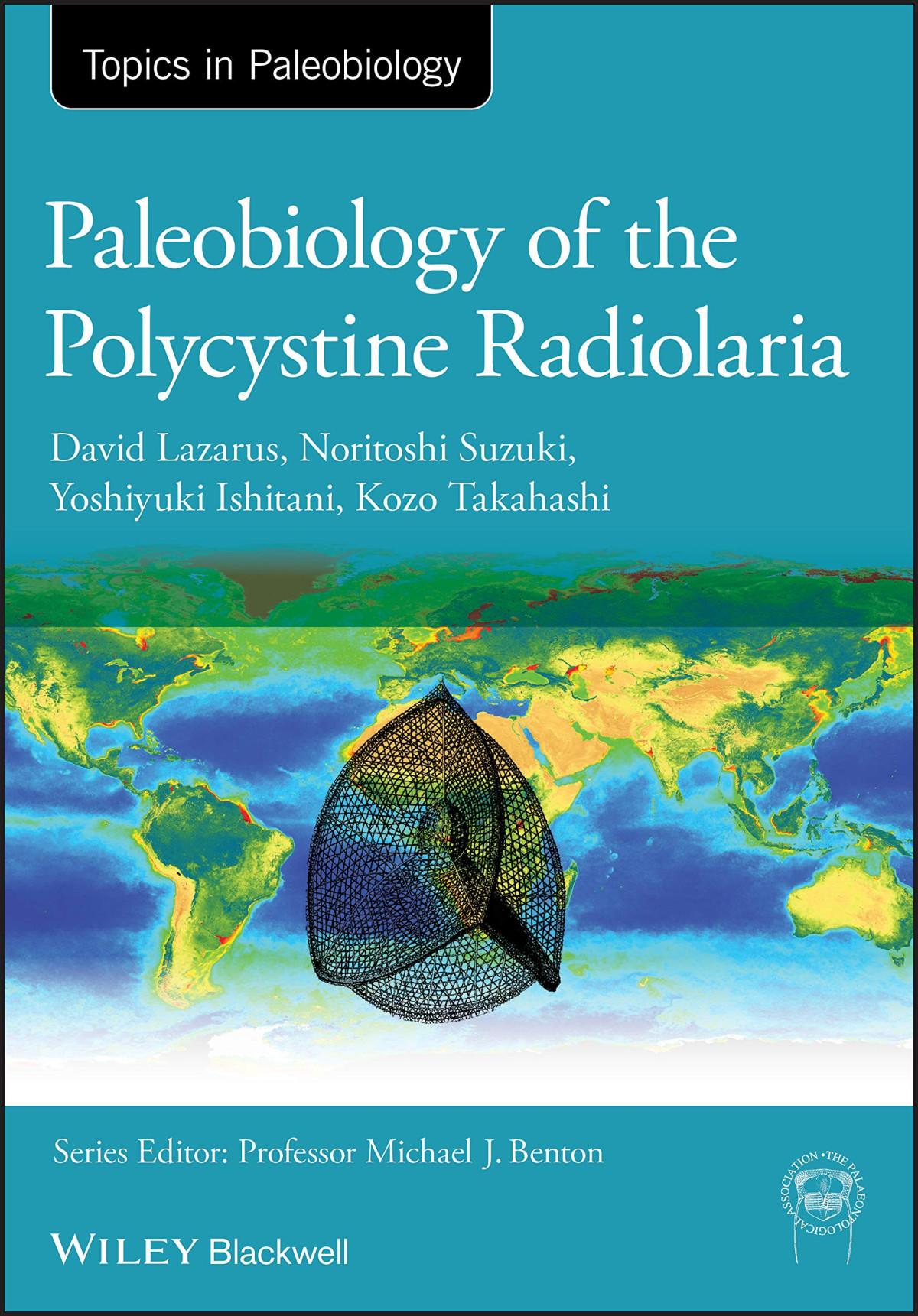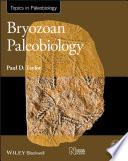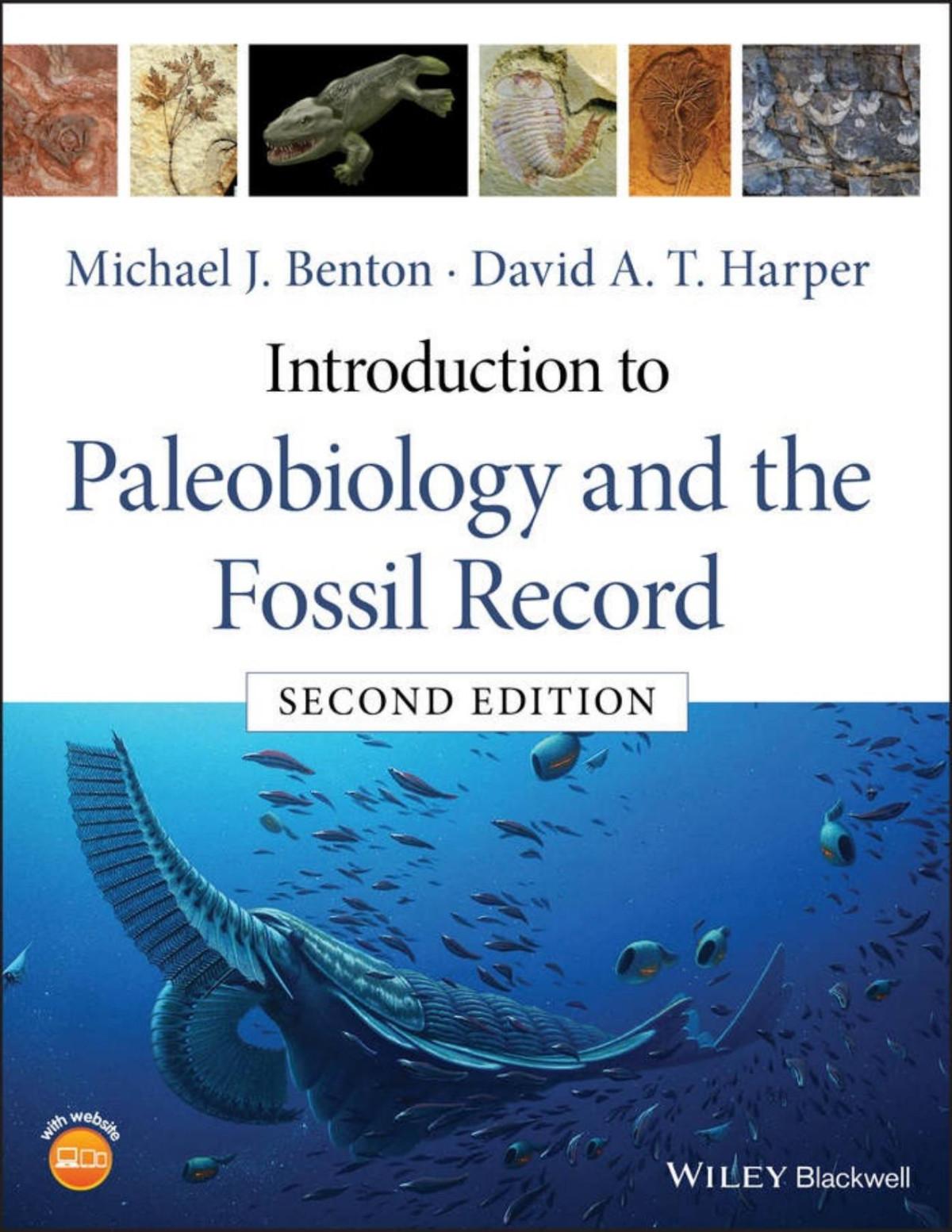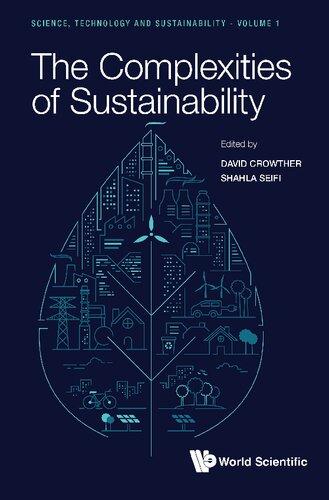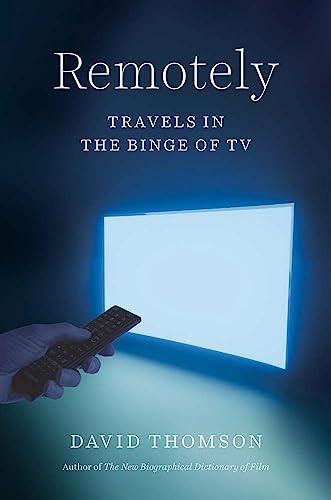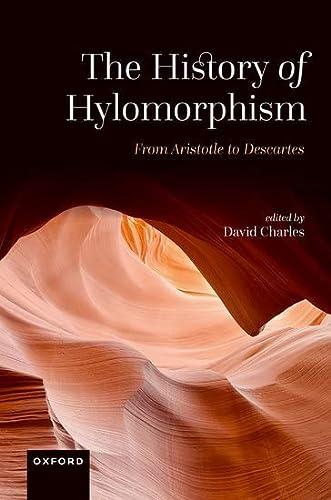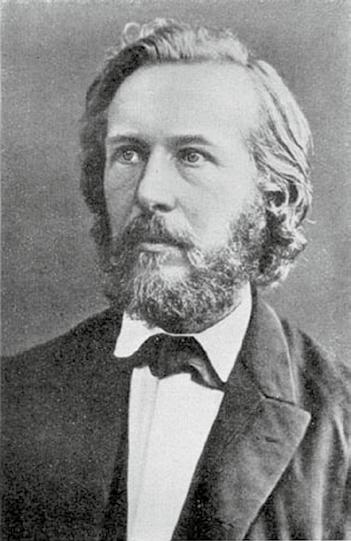Paleobiology of the Polycystine Radiolaria
David Lazarus
Museum für Naturkunde Invalidenstrasse 43 Berlin, 10115, Germany
Noritoshi Suzuki
Tohoku University
Aoba-Ku, Sendai City 980-8578, Japan
Yoshiyuki Ishitani
University of Tsukuba Tsukubashi, Ibaraki, 305-8577, Japan
Kozo Takahashi
Kyushu University
744 Motooka Nishi-ku, Fukuoka 819-0395, Japan
This edition first published 2021 © 2021 John Wiley & Sons Ltd.
All rights reserved. No part of this publication may be reproduced, stored in a retrieval system, or transmitted, in any form or by any means, electronic, mechanical, photocopying, recording or otherwise, except as permitted by law. Advice on how to obtain permission to reuse material from this title is available at http://www.wiley.com/go/permissions.
The right of David Lazarus, Noritoshi Suzuki, Yoshiyuki Ishitani and Kozo Takahashi to be identified as the authors of this work has been asserted in accordance with law.
Registered Office(s)
John Wiley & Sons, Inc., 111 River Street, Hoboken, NJ 07030, USA
John Wiley & Sons Ltd, The Atrium, Southern Gate, Chichester, West Sussex, PO19 8SQ, UK
Editorial Office
9600 Garsington Road, Oxford, OX4 2DQ, UK
For details of our global editorial offices, customer services, and more information about Wiley products visit us at www.wiley.com.
Wiley also publishes its books in a variety of electronic formats and by print-on-demand. Some content that appears in standard print versions of this book may not be available in other formats.
Limit of Liability/Disclaimer of Warranty
While the publisher and authors have used their best efforts in preparing this work, they make no representations or warranties with respect to the accuracy or completeness of the contents of this work and specifically disclaim all warranties, including without limitation any implied warranties of merchantability or fitness for a particular purpose. No warranty may be created or extended by sales representatives, written sales materials or promotional statements for this work. The fact that an organization, website, or product is referred to in this work as a citation and/or potential source of further information does not mean that the publisher and authors endorse the information or services the organization, website, or product may provide or recommendations it may make. This work is sold with the understanding that the publisher is not engaged in rendering professional services. The advice and strategies contained herein may not be suitable for your situation. You should consult with a specialist where appropriate. Further, readers should be aware that websites listed in this work may have changed or disappeared between when this work was written and when it is read. Neither the publisher nor authors shall be liable for any loss of profit or any other commercial damages, including but not limited to special, incidental, consequential, or other damages.
Library of Congress Cataloging-in-Publication Data
Names: Lazarus, David B., 1954- author. | Suzuki, Noritoshi, author. | Ishitani, Yoshiyuki, 1982- author. | Takahashi, Kozo, author.
Title: Paleobiology of the polycystine radiolaria / David Lazarus, Noritoshi Suzuki, Yoshiyuki Ishitani, Kozo Takahashi.
Description: Hoboken, NJ : Wiley-Blackwell, 2021. | Series: Topics in paleobiology | Includes index.
Identifiers: LCCN 2020020074 (print) | LCCN 2020020075 (ebook) | ISBN 9780470671443 (paperback) | ISBN 9781119697527 (adobe pdf) | ISBN 9781119697466 (epub)
Subjects: LCSH: Radiolaria, Fossil. | Radiolaria.
Classification: LCC QE773 .L39 2021 (print) | LCC QE773 (ebook) | DDC 561/.995--dc23
LC record available at https://lccn.loc.gov/2020020074
LC ebook record available at https://lccn.loc.gov/2020020075
Cover Design: Wiley
Cover Images: World map © NASA, Callimitra Haeckel Transparent from Report on the scientific results of the voyage of H.M.S. Challenger during the years 1873-76 under the command of Captain George S. Nares … and the late Captain Frank Tourle Thomson, R.N.
Set in 9/11.5pt TrumpMediaevalLTStd by SPi Global, Chennai, India
Formal Classification of Polycystina
Order Spumellaria Ehrenberg 1876
Family Actinommidae Haeckel 1862
Family Heliodiscidae Haeckel 1881
Family Coccodiscidae Haeckel 1862, emend. Sanfilippo and Riedel 1980
Family Pyloniidae Haeckel 1881
Family Lithelidae Haeckel 1862
Family Tholonidae Haeckel 1887
Family Spongodiscidae Haeckel 1862
Order Nassellaria Ehrenberg 1876
Family Plagiacanthidae Hertwig 1879
Family Trissocyclidae (Haeckel) Goll 1968 [superfamily Acanthodesmiacea]
Family Theoperidae Haeckel 1881
Family Artostrobiidae Riedel 1967
Family Pterocoryithidae (Haeckel) Moore 1972
Family Carpocaniidae (Haeckel) Riedel, 1967 [Carpocaniinae]
Family Cannobotryidae Haeckel, 1881
Superfamily Collodaria
Family Collosphaeridae Müller, 1858
Family Sphaerozoidae Haeckel, 1862
Family Collophidiidae Biard and Suzuki, in Biard et al., 2015
Family Orosphaeridae Haeckel, 1887
Family Saturnalidae Deflandre 1953
and Paleozoic Taxa
Species-Level Variation in Radiolaria
to the Lower Carboniferous
Late Paleozoic to Late Mesozoic Siliceous Sedimentation
Mass Extinctions at the End of the Paleozoic Era
Basal Mesozoic Scarcity of Radiolarian Fossils and Faunal
(Early Triassic)
Preface
This book summarizes current understanding of the marine planktonic protist group Polycystina, or informally, the polycystine radiolaria, both in living and fossil form. Although the organisms are small and the number of researchers working on them at any moment in time is also not large, their study spans a great range of specialties, from molecular biology to marine geology. For this reason, a team of specialists has worked together to create this volume. Our approach to the book also takes into consideration both the intellectual challenges of understanding this broad, highly interdisciplinary subject, as well as the changing nature of communications in the modern world. In contrast to many other specialty volumes, and to some extent to the few other older existing books on radiolarians (summarized below), we have chosen to emphasize concepts and basic principles, rather than to compile a large number of facts. One of the most important things to understand about a new subject are the underlying concepts that guide workers in the field. These are often so widely accepted that they are usually assumed, and rarely articulated, yet are essential to understanding the activities, data, and interpretations that make up the visible content of the field; nor are these concepts always the same as those used in other areas of intellectual activity, creating major barriers to understanding between
disciplines. By contrast, it is becoming increasingly easy for individuals to themselves assemble enormous amounts of raw information – piles of data and interpretations of it – by electronic means. This includes searching the internet, using local and online databases of scientific publications, and searching archives of published literature, both local and online. We have, therefore, deliberately emphasized providing the relatively hard-to-find explanations for conceptual issues, and give only a subset of citations to the factual data behind them, to serve as a starting point for further self-guided study by the reader.
What are polycystine radiolaria, and why study them? The term radiolaria is itself in need of definition. Historically, it was created to refer to several superficially similar groups of marine zooplanktonic protists who share a similar structure of a central nucleus and cytoplasm surrounded by a halo of radiating, partially stiffened, filamentous pseudopods; and, with few exceptions, possessing a mineralised skeleton or shell. Three major biologic groups come under this definition: the Polycystina, the Acantharia, and the Phaeodaria. Recent molecular work has established that these three groups are not all that closely related to each other; further, only the Polycystina’s massive siliceous shells are commonly found in fossil form. Thousands of fossil species have been described, from rocks
dating back to the base of the Phanerozoic – e.g. the entire time period in which fossils are at all common in the geologic record. In the last few years it is also becoming apparent that polycystine radiolarians are an important component of the living plankton. These are the basic justifications for the focus on Polycystina in this book, as it is their biology and geologic record that currently is of greatest interest to science. Indeed, given the dominance of interest in this one group, we, as is common to many other workers, will usually simply use “radiolaria” to refer to the polycystines, only using the latter term when a differentiation to acantharians or phaeodarians is needed. There are in addition two other reasons for a book on the paleobiology of radiolarians. The lesser reason is simply that it has been nearly 20 years since the previous standard reference book on radiolarians (De Wever et al., 2001) appeared, and a new work summarizing research developments in the last two decades is urgently needed. The more important reason though is that radiolarian research is undergoing a major change in orientation. New technologies, particularly molecular biology, automatic data collection using AI computer systems, and global database networks are opening vast new opportunities for biologically oriented research using both living and fossil radiolarians. While classic themes such as biostratigraphy and paleoceanography are not in danger of dissapearing, the focus nonetheless in the next decades will increasingly shift towards (paleo)biologic studies, including biologically based higher systematics, micro and macroevolution, and integrated studies of diversity and environmental change. This book we hope will provide a starting point to help train the next generation of radiolarian workers in these subjects. Radiolarians are exclusively marine and are found in all ocean waters, from polar regions to the tropics, and at all water depths, from the well-mixed surface layer to abyssal waters. There are approximately
600 distinct described living species and several thousand fossil species of polycystines. Radiolarians in general, and polycystines in particular, were until recently not thought to be a major component of the living plankton and were not so intensively studied as groups, e.g. diatoms or coccolithophores, with perceived greater abundance and/or impact on marine ecosystems and geochemical cycles. As fossils, radiolarians are however fairly common, and often occur in sediments where other types of fossils are absent. This has made them very valuable for certain types of geologic research, particularly estimating the geologic age of the sediments containing them, and as guides to past oceanic water conditions. As our current understanding of the biology, and even taxonomy of the living fauna is still very incomplete, evolutionary studies based on living polycystines are still rare. However, the common occurrence of numerous specimens for many species, and in a wide variety of oceanic environments, also provides an excellent opportunity to study biologic evolution in the fossil record. Thus, the structure of the book is approximately three-fold: after a historical introduction, three chapters on living radiolaria; two chapters on general information (a large chapter on taxonomy with a summary of the fossil record, and a shorter chapter on preservation and methods); and a concluding three chapters on research applications: paleoceanography, stratigraphy, and evolution. Given the title of this series of volumes (“Topics in Paleobiology...”) we have presented evolution in more detail than our coverage of subjects in the other chapters. We also have, in contrast to earlier books on radiolaria, clearly separated general observations of radiolarian change over time (Chapter 5) from the use of these data in understanding evolutionary processes (Chapter 9). Of particular interest are two chapters which are the first such to appear in book form. Our book begins with a historical review of this
field of research. This is of interest for anyone studying the history of science, but also gives a context for the rest of the book’s content. Much of what we know, and do not know about radiolarians, depend on the historical constraints of how this field of knowledge developed. The chapter on the newly developing subject of radiolarian genetics and molecular systematics is also a first to appear in book form. Certain assumptions are made about the readers of the book. It is expected that the reader has completed a bachelor’s degree or equivalent in one of the natural sciences, ideally either biology or the earth sciences, and, as stated above, is willing to find additional factual data themselves, using our text as a starting point. Since not all readers will have the same degree of interest in all aspects of this subject, and many will primarily need to consult specific parts for reference, we have tried to write the text so that each chapter can, to some degree, stand alone, although we provide cross references to other relevant parts of the volume whenever possible. This does mean also a certain degree of overlap and/or duplication, but in most cases only at the most superficial level, with detailed exposition, hopefully, being confined to a single, most logical place in the text. We also specifically wish to make radiolarians accessible to the widest possible range of specialists, and thus have deliberately included a fair amount of required background on many subjects in biology and the earth sciences, as specialists in one rarely have much background in the other.
Since we stress the need to use information sources beyond the content of this book it is important to note some more specific sources here, beyond those general resources known to everyone in the internet age. There are several such available to beginning students of radiolaria, including both books and online databases with taxonomic, geographic, and geologic age distributional information.
There are three other reasonably modern book-length treatments of radiolarians available in the western literature. Each of these has its own special strengths which complement the content of this volume.
Radiolaria, by Anderson (1983). This book is the first book published in the twentieth century in the West specifically devoted to radiolarians. The focus is strongly on radiolarian biology and the fossil record is covered somewhat sketchily, primarily in the context of evolutionary studies. Dr. Anderson’s speciality of radiolarian cellular biology is excellently summarized and in most respects this volume is still the best, most detailed reference for this aspect of radiolarian biology available.
Radiolarians in the Fossil Record by De Wever et al. (2001). As the title suggests, this book was seen as a complement to the earlier work by Anderson, focusing on the geologic aspects of radiolarians rather than the biologic ones. In addition to chapters on the use of radiolarians in geologic research, this volume presents, for the first time, a complete family-level classification of radiolarians, both fossil and living. In all, 131 families are defined, and short but adequate summaries of the key morphologic characters are given for all of these. This taxonomic section, at 208 pages, makes up nearly half of the De Wever volume (ignoring references and indices). It is thus far more detailed than any that we could attempt in our own work, and still leave adequate room for coverage of other topics. It is partially for this reason that the taxonomic section of our own book makes no attempt to be comprehensive but instead concentrates on principles and specific examples (mostly for the Cenozoic geologic time interval); as for more detailed treatment of other families the reader can make use of the De Wever volume. We do, however, provide a critique of this, and other attempts to synthesize radiolarian taxonomy, to enable the reader to better evaluate the often conflicting details of taxonomy present in the literature.
Lastly, the monographic-length special issue of Afanasieva et al. (2005), provides a recent summary of radiolarian studies from the viewpoint of mostly Russian workers. This work is available both in the original Russian, and in English translation, which makes it much more accessible than earlier monographic publications from the Soviet Union (e.g. Petrushevskaya, 1971, 1981, 1986) which were published only in Russian. As explained in our chapter on the history of radiolarian research, distinctly different “schools” of radiolarian studies developed in the Cold War years in the West and the Soviet Bloc, and many differences in both content and basic approach to the subject still exist. In our book we refer to this body of research when appropriate, but do not attempt to fully synthesize or harmonize the sometimes still strongly disparate ideas and information.
In addition to these more general reference works, and a variety of more specialized resources cited within the book as appropriate, e.g. for biostratigraphy, there are other resources which give more comprehensively the specifics of radiolarian taxonomy and distribution at the level of species and genera, albeit without the interpretive aspects found in the above books. These resources are essential since as yet, there are no comprehensive reference catalogs for radiolarian species and generic taxonomy. These resources include:
The NSB (Neptune) database (www.nsbmfn-berlin.de) which gives basic taxonomic information plus name status (e.g. valid, synonym) for most of the several thousand species mostly of Cenozoic age, plus (as of 2019) over 135,000 species occurrence records derived from the deep-sea drilling project cores detailing their distribution in space and time; The Paleobiology Database (https:// paleobiodb.org) – the main general paleontology database, it has substantial radiolarian occurrence data (as of January 2020 ca. 48,000 occurrence records, of
which however only about 27,000 are identified to species level), mostly for the Mesozoic;
Several papers in a special issue of Geodiversitas (O’Dogherty et al. 2009) which collectively comprehensively cover the genus taxonomy of Mesozoic radiolarians, plus a similar compendium for the Paleozoic (Caridroit et al., 2017); The radiolarian taxonomic database based on Paleotax (Suzuki, 2016) and the RadWorld taxonomic database (Caulet et al.), neither of which as yet are available to the general public;
The multi-organism taxonomic database at http://bio-world.org (note – the content of this database is quite extensive – about 20,000 radiolarian names, but decidedly mixed quality; also, the database’s name and web address changes frequently; And lastly, the radiolarian community website www.radiolaria.org. This site provides general information about radiolarians to the world of internet users, news and announcements for the community of radiolarian researchers, and an online catalog of several hundred (primarily) Cenozoic to Recent species, with description, images, and synonymies.
In addition to the above, two other projects are in progress but have not yet appeared in public form. Caulet et al. (2017) are preparing a catalog of Cenozoic genera, and Cenozoic workers are beginning to prepare a more comprehensive online catalog of both species and genera using the Mikrotax system (http://www.mikrotax.org/index.php).
Lastly we note the authorship of this multi-author effort. Suzuki wrote initial drafts of Chapter 2 and the Paleozoic and Mesozoic parts of Chapters 5 and 8; Takahashi contributed to Chapters 3 and 6, and Ishitani wrote the draft of Chapter 4. Lazarus revised and substantially extended these initial drafts and created all other content, and is thus primarily responsible for the interpretations and conclusions of this book.
History
Introduction
The history of radiolarian research begins in the mid-nineteenth century, with research activity continuing with widely varying intensity and focus up to the present day. Unlike large primary divisions of science which have their own internal dynamics, radiolarian studies have always been carried out by relatively small numbers of individuals. Their work has been very strongly shaped by the development of the larger scientific subjects within which radiolarian research has been embedded. It is thus not possible to understand the historical development of the field without also understanding something of the history of these larger fields within which radiolarian studies have been carried out. These include biology, both in general, and specifically protistan biology and marine biology (particularly plankton); and earth sciences: paleontology, stratigraphy, and paleoenvironmental studies – e.g. paleoclimatology and paleoceanography. All of these disciplines have significantly affected the type and intensity of radiolarian research. This chapter thus covers not only radiolarian research but, to the degree appropriate, developments in these other disciplines as they affected the development of radiolarian research.
Bibliographic summaries of radiolarian research provide an overview of activity in the field. Because different bibliographies,
Paleobiology of the Polycystine Radiolaria, First Edition. David Lazarus, Noritoshi Suzuki, Yoshiyuki Ishitani and Kozo Takahashi. © 2021 John Wiley & Sons Ltd. Published 2021 by John Wiley & Sons Ltd.
each with different degrees of completeness and detail, are available, it is best to look at data from multiple sources (Figures 1.1, 1.2). Species descriptions (Figure 1.1a) provide one measure of research activity as taxonomic work is a foundation for other types of research. After a modest degree of publication in initial period of study from ca. 1840–1870, there is a huge spike (due to Haeckel’s Challenger monograph, described in “E. Haeckel and his disciples”) in the late 1880s, followed by a period of moderate activity up to ca. 1910 or so, after which taxonomic research on radiolarians dropped to very low values until the late 1950s, other than a couple of “spikes” due to some monographic papers in the late 1920s and mid-1940s. Taxonomic work on radiolarians then, from ca. 1960 or so, increased gradually to levels higher than seen in earlier times, followed by a decline in annual species numbers from around 1980 on. Interestingly, a rather parallel pattern of initial interest up to the beginning of the twentieth century, then a period of decline until ca. the 1950s, is also seen in the history of diatom research (Stoermer and Smol, 2010).
If, instead of using numbers of species, one plots numbers of papers (Figures 1.1b, 1.2), a rather different picture emerges. Although there are still two peaks in publication activity, one in the late nineteenth century, and the other in the 1980s, the relative sizes of the peaks are now dramatically different, with many more papers being published in the twentieth, vs. nineteenth century. More papers with time reflects a general pattern in the history of science, where scientific activity and numbers of publications increase rapidly in the twentieth century – indeed, for academic publishing as a whole, the trend has been more or less one of continuous geometric increase with doubling times of 15–24 years since the early nineteenth century, measured either by publications (Larsen and von Ins, 2010) or numbers of journals (Jinha, 2010). Several aspects of the radiolarian publication history however differ from the general pattern of scientific publication.
First, the ratio between numbers of new species and numbers of papers has changed dramatically over time, with nineteenthcentury work being dominated by many new species descriptions in a small number of papers, while twentieth-century studies published, per paper, many fewer species, even if due to the larger
total number of papers the total taxonomic output is similar. There is thus either a fundamental change in the style of taxonomic publishing, and/or a shift in publication to non-taxonomic research. Both are probably significant factors. It is possible even today for a student to encounter a nearly unknown radiolarian assemblage which needs to be sorted into species categories without the help of prior literature. This effort, vastly eased by modern imaging technology, can now be done for hundreds of species in a few months’ work. However, without the need to reference prior literature, early workers could publish simple descriptions of large numbers of species relatively easily. There is of course also a shift toward applied work with radiolarians over time, so that, unlike in early years, more recent literature is dominated by papers that contain no new taxonomy.
Second, there is a substantial decline in outputs in both taxonomic description and general numbers of publications in the last ca. 20 years. Although this is in part due to incomplete recording in the last ca. 10 years, the similarity between different data sources, and in particular in the relatively comprehensive Paleotax data, suggests that the decline in output is real. This is not a general feature of science publication, which continues to grow rapidly (Larsen and von Ins, 2010; Jinha, 2010). Lastly, there are noticable differences in activity between subdisciplines. Subdisciplines in radiolarian research are, due to many differences in material and the research context that are linked to geologic age, conveniently expressed by the geologic time interval that individual studies examined (living; Cenozoic; Mesozoic; Paleozoic: Figure 1.2). Research on Cenozoic/living radiolarians dominates nineteenth-century studies, and increases relatively rapidly after WWII to a plateau by around 1970, before gradually declining in the 1990s to the present day. Mesozoic and Paleozoic studies by contrast begin to increase in the 1970s and 1980s, respectively, before declining in the beginning years of the twenty-first century. These differences create different time intervals of dominance, with Cenozoic/living being the dominant area of research up to ca. 1980, and Mesozoic research being the dominant activity after this time. The causes of these patterns will be described in our historical review.
These patterns suggest convenient time intervals in which to frame a review of radiolarian reseach: early studies up to around
1910, the low activity interval between 1910 and ca. 1950, the growth period of Cenozoic/living studies up to ca. 1970, and the “modern” phase of research beginning in the 1970s and continuing to the present day. The small (third) peak in publication seen in all data beginning in the late 2000s may represent a new phase of research, though this is more open to interpretation, and will be discussed together with “outlook – future developments” at the end of this chapter.
Within the field of radiolarian studies, the number of species descriptions by author (see Table 5.5) provides at least a rough guide to the importance of individual workers, particularly in earlier times when descriptive work dominated research activity.
Scientific Context
The first of the broader issues that influenced early studies of radiolarians are the basic framework ideas on the development of science itself, as early radiolarian research grew up during this period of general scientific development. Modern science, with its distinguishing characteristics of emphasis on non-metaphysical material mechanisms as the cause of the patterns and structure of the natural world, formal hypotheses, and testability, is generally agreed to have originally developed primarily in Europe over several centuries, but maturing in the eighteenth and nineteenth centuries (Wikipedia contributors, 21.6.2018). By the mid-1800s natural sciences were firmly established in western countries and divided into the major divisions we still use today, with numerous professional positions in universities, supported by professional societies and other coordinating organizations. Even the name was modern, with the term “scientist” (coined by W. Whewell in 1833) gradually replacing the earlier, less distinctive term “natural philosopher” (https:// en.wikipedia.org/wiki/William_Whewell; accessed 3.9.2017). In other parts of the world descriptive and sometimes quite extensive studies of nature analogous to the
descriptive studies of biodiversity in the western world were also developing, e.g. in Japan (Marcon, 2015). These activities were linked, as in western countries, to other interests (medicine, agriculture, hobby gardens, and others) but they were not systematically linked to developing formal paradigms of scientific hypotheses and testing as in the West. Nor, lacking widespread access to microscopes and other suitable technology, was the systematic study of microorganisms possible.
The development of science in Europe was gradual and not uniform between disciplines, with physical science developing more rapidly than biologic. At the beginning of the nineteenth century however, the transition in biology from a descriptive style to one where description was informed, and thus influenced by scientific theories of process, was already underway. Initial steps in this transformation included a re-examination of the “scala natura” description of the natural biologic world that had been inherited from antiquity (traceable back to Plato), and had been overlain with religious-metaphysical mechanisms (Mayr, 1982; https://en.wikipedia. org/wiki/Great_chain_of_being, accessed 21.6.2018). Observations of the diversity of life had been until then pressed into a
Figure 1.1 Publishing activity over time for radiolarian research. a) shaded – number of new species per year (3-point smoothing); b) bold line – number of publications per year (Suzuki database with 3-point smoothing); c) thin line – number of publications per year with “radiolaria” in the title in Google Scholar, 1988–2018 (searched August 2019). The Suzuki database primarily records taxonomic literature and thus underestimates applied radiolarian research where radiolarians are used but no new taxonomy is published. However, a simple Google Scholar search for radiolarian papers, not specifically taxonomy, gives a very similar trend, albeit with higher total numbers of papers.
description of a continuous chain of forms, from the simplest to the most complex, perfect forms (man, and above this the metaphysical beings of angels and god). The simplest forms at the base merged into and continuously arose from the inorganic world below via spontaneous generation –an idea which, although long under attack, was still present well into the early nineteenth century (https://en.wikipedia .org/wiki/Spontaneous_generation, accessed 22.6.18). More objective study showed numerous flaws in this description, weakening the metaphysical/religious explanations of mechanism tied to this description. Cuvier for example demonstrated in 1812 that there was not a continuous series of forms among metazoans (Mayr, 1982). A series of tests, culminating in Pasteur’s
1859 experiment, finally disproved the idea of spontaneous generation. New scientific theories, based on these more objective descriptions of nature, and using materialistic mechanisms, were proposed in to replace the scala natura. Several theories of evolution were also developed, such as those of Lacépède and Lamarck, although these lacked an adequate mechanistic basis (Mayr, 1982). These earlier ideas were replaced later in the century by Darwin’s evolutionary theory (Darwin, 1859).
The idea that all life was made of cells was published by Schleiden (1839) and Schwann (1839), and that all cells arise from other cells (and thus not, at the base of the chain, from the inorganic world) was proposed by Raspail in 1825 but only popularized by Virchow in 1858 (Enerson, 2018).
Figure 1.2 Numbers of papers published per year by geologic time interval, from reference database of radiolarian literature distributed at the Cadiz Interrad meeting (2012). Light grey: Paleozoic; Dark grey: Mesozoic; Dotted line: Cenozoic; Solid line: Living. Data smoothed (3-point moving average) for clarity. Cadiz literature database includes many applied papers and papers without the word “radiolaria” in the title but does not include as many titles per year for pure taxonomy as the Suzuki database.
Early studies in Europe using primitive microscopes had documented the existence of microscopic life forms, (e.g. J. Hill 1652, van Leeuwenhoek 1674: Corliss, 1975), and O.F. Müller (1770s and 1780s), but little was known about their biology or diversity even in the early nineteenth century (Corliss, 1978). Improved microscopes in the mid–late nineteenth century, however, were enabling new insights on microscopic life, in particular from various innovations in lens and illumination design in the 1830s to 1870s (Croft, 2006).
Increasing wealth and technologic power from the industrial revolution meant increased resources were available to more systematically explore remote environments, including the open oceans. Scientific studies of these had begun already in the 1700s, but the number of expeditions increased substantially in the later 1800s, most notably with the Challenger expedition of 1872–1876 (Lalli and Parsons, 1993;
Figure 1.3). The Challenger Expedition grew out of the first systematic studies of marine organisms by E. Forbes and the discovery in 1860 of abundant life growing on a deep-sea telegraph cable. This disproved Forbes’ 1843 Azoic Theory of no life in the deep oceans and stimulated new research on the vast, scientifically unknown biologic realm of the open oceans. Plankton studies would become a regular part of the research program on such expeditions, though “plankton” as a distinct concept was not coined until 1887 by V. Henson, who subsequently, in 1889, would lead the German “Plankton Expedition” – the first specifically devoted to study of planktonic organisms. (The study of the radiolarians from this expedition by Brandt were however mostly on the poorly fossilizing Collodaria.) This expedition’s financing provides an example of the growing commercial interests in ocean environments, as a significant contribution to the costs was donated by the German
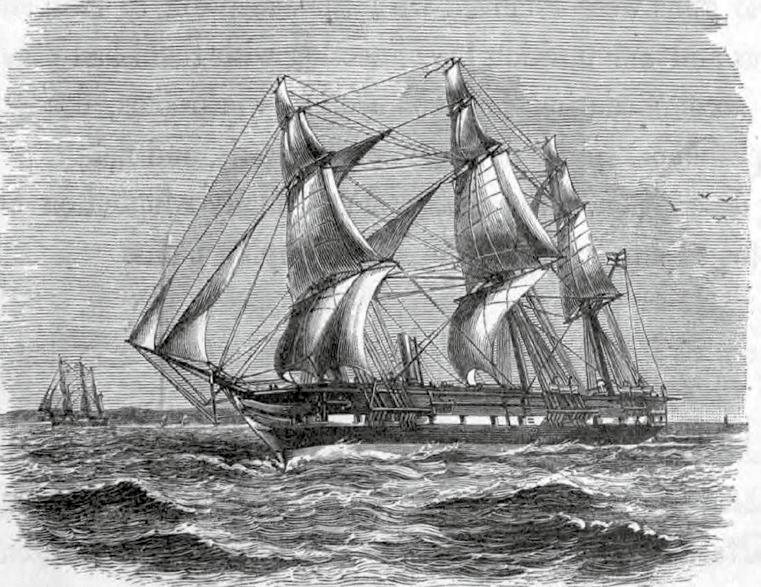
Figure 1.3 The H.M.S. Challenger. Primarily known for its seminal ocean research expedition (1872–1876) which circumnavigated the globe, covered 127,580 km, and explored all major ocean basins from the tropics to polar regions. A small shipboard staff of six scientists led by C.W. Thomson took physical oceanographic measurements, and collected water, plankton, and deep sea samples during the cruise which were distributed to numerous other scientists when the expedition ended, including E. Haeckel, for radiolarian studies. Source: Wikimedia Commons.
commercial industry’s Fisheries Association (Deustcher Fischereiverein) (https:// de.wikipedia.org/wiki/Deutscher_FischereiVerband, accessed 6.9.2017). In a parallel development, the late 1800s saw the establishment of several marine biology laboratories, e.g. the Naples laboratory in 1872, and the Marine Biologic Laboratory in the USA in 1873 (moved to Woods Hole in 1888; Lalli and Parsons, 1993). The Naples Zoological Station was particularly important to the development of marine biologic research. Founded by A. Dohrn, a zoologist and later evolutionist who had studied in part under the famous radiolarian researcher
E. Haeckel in Jena, the Naples Station was an “open” facility, which could be used by visiting scientists from any country, who paid (an innovation itself) “bench fees” for using the facility (Cortese, 2014).
Geology in the first half of the nineteenth century was still primarily a practical, descriptive science, and considerable energy was devoted to stratigraphic categorization, mapping, and similar activities, though major debates on tectonics and other geologic themes were present (Gohau, 1990). Theoretical work was supported by the work of Lyell and others who had largely established the required basic
principles such as uniformitarianism (the geologic record is to be interpreted as resulting from processes known in recent times).
Historical geology however was still hampered, despite the spread of Lyellian uniformitarianism, by religious requirements for a very young age for the earth. The basics of stratigraphy were well established, even if the number and names of stratigraphic divisions were still in a state of flux. Biostratigraphy was also an established tool, having been founded by W. Smith (e.g. “Strata Identified by Organized Fossils,” published 1816–1819). A. d’Orbigny in 1840 introduced the use of microfossils (specifically foraminifera) for biostratigraphic purposes. Micropaleontology as a distinct field had however not developed – indeed, d’Orbigny himself at first saw foraminifera simply as very small cephalopods. This was corrected by Dujardin’s 1835 observation that micro-organisms are unicellular (Corliss, 1978; Vénec-Peyré and Bartolini, 2013). Toward the end of the nineteenth century, geology became more closely allied to expanding industrial and national interests, with the founding of numerous geological surveys and extensive field geologic studies to map and identify natural resources. The United States Geological Survey, for example, was founded in 1879 (Rabbitt, 1975). These activities, along with the discovery and increasing use of oil deposits at the end of the century, would also have a major impact on radiolarian research, but not until well into the twentieth century.
Early Studies (First Half of the Nineteenth Century)
C.G. Ehrenberg and J. Müller
Radiolarians during the first half of the nineteenth century were known only from relatively inconsequential, minor notes in early biologic surveys, e.g. Meyen (1834), and had not yet been studied in any significant way
in fossil form. Radiolarian study (and micropaleontology in general) really began with the work of C.G. Ehrenberg, who systematically described numerous fossil forms (but very little living material), and J. Müller, who initiated study of living radiolarians in 1855 (Lazarus, 2014).
Christian Gottfried Ehrenberg (1795–1876, Figure 1.4) grew up in Delitzsch, Germany, and developed an interest in natural history while still a Gymnasium student. This led him to break off his initial study of theology and take his degree (1818) in medicine at the university in Berlin, as at this time the study of biology was still closely connected to the field of medicine (Wetzel, 1966; Mayr, 1982). Ehrenberg at first studied a variety of plant and animal species, and as a biologist took part in two expeditions: one to the Near East (1820–1826, under the leadership of the
Figure 1.4 Christian Gottfried Ehrenberg (1795–1876). Source: Museum für Naturkunde historical document archives.
Prussian general J.H. v. Minutoli), and a second to Russia (1829). The former expedition was in many ways disastrous, as it was underfunded and poorly planned, and the majority of the participants died of illness before it was completed (Siesser, 1981). For Ehrenberg, who lost his friend Hemprich to illness during the expedition and only narrowly survived himself, it was a double disaster. His painfully collected scientific materials (ca. 80,000 specimens that had been mailed to Berlin) had been mishandled. Many of the specimens had been sold to other scientists or collectors, and most of the labels on those still remaining had been lost. Ehrenberg soon turned to the study of microorganisms. Some he collected himself in Berlin or in Germany; many more were sent to him by other naturalists as his fame as “the” microorganism specialist grew with the years. Ehrenberg’s exceptional knowledge of microorganisms was known as well beyond the realm of scientists and naturalists; he was not infrequently invited to meetings of high society (on one occasion the King of Prussia) to set up his microscope and show off his microorganisms to those assembled (Jahn and Landsberg, 2000). Ehrenberg’s fame was deserved. Although protists had been described sporadically for many decades, even the more detailed studies, e.g. by O.F. Müller (1730–1784, posthumous publication 1786), tended to mix protist and metazoans together. Initial definitions of them as a group, while recognizing their distinctiveness, also implied their primitive, simple nature, as the word “protozoa,” coined by Goldfuss in 1817–1818 clearly suggests. Goldfuss placed Protozoa at the base of the scala natura, emerging from the “Urschleim” [primeval slime] (Entzeroth and Hausmann, 1993). Ehrenberg was the first to systematically study a broad range of living and fossil microorganisms and to document them as widespread, diverse, complex, highly developed forms of life. He thus can be considered the father of protozoology and, together with A.
d’Orbigny, the cofather of micropaleontology (Corliss, 1978; Siesser, 1981). He described thousands of new species, including many of the type species for common genera in important groups of microorganisms, such as the diatoms (Jahn, 1998; Lazarus, 1998). Ehrenberg did not have the ability to understand the geologic aspect of the fossils he studied as most of the geologic age assignments at that time were still extremely imprecise (e.g. Tertiary vs. Cretaceous) and even these were frequently wrong (Zittel, 1876, p. 76). His importance is that, other than the short, one-page description of a single species (the collodarian colony Sphaerozoum fuscum by Meyen, 1834), he was the first to systematically study and describe radiolarians.
Ehrenberg’s doctoral thesis on fungi had demonstrated that they developed by normal biologic means of reproduction, and not, as the still commonly believed medieval (or older) theory of scala natura (also known as “the great chain of being”) suggested, by development from lower forms. Finding evidence to refute the scala natura theory remained important to Ehrenberg’s later scientific development, as in his studies of microorganisms he stressed their complex nature and constancy in characters, both characteristics that he felt refuted the predictions of scala natura, which claimed that lower forms of life were ever simpler, less developed, and had a tendency to transform into other life forms along the “scale”; and at the base (where microorganisms were assigned), a seamless transition occurred to the inorganic realm (Mayr, 1982). The scala natura was however, regardless of popular belief, already largely disproven to many other contemporary biologists, e.g. from Cuvier’s (1812–1817) studies of animal systematics (Mayr, 1982). Ehrenberg went so far in his effort to establish the complexity of microscopic life as to claim that the organelles of living protist cells were in fact miniature organs, fully homologous with those of macroscopic,
multicellular life forms. In this he rejected the discoveries of other biologists on the unicellular nature of microorganisms (e.g. Dujardin, 1835). His biases on the constancy of species (based in part on comparisons using broadly defined genera, e.g. Ehrenberg, 1839, p. 154 on Haliomma, which he found living in ocean water and in “Cretaceous” rocks from Greece) and gaps between forms similarly led him later to reject Darwin’s evolution theory. These contrarian views resulted in much of his work being, if not rejected in its entirety, nonetheless being neglected by both contemporary and later generations of biologists (Wetzel, 1966; Siesser, 1981). T.H. Huxley, for example, described Ehrenberg’s research (and before the publication of Darwin’s Origin) as “wonderful monuments of intense and unremitting labour, but as least as wonderful illustrations of what zoological and physiological reasoning should not be” (Huxley, 1851, p. 436 – with several following pages rebutting Ehrenberg’s ideas). Ehrenberg also persisted in using the same microscope throughout his career (Figure 1.5; pers. comm. T. Mappes, 6.8.19) even though it was technically increasingly obsolete, and did not yield the same quality images as newer models (Siesser, 1981).
Despite these weaknesses, Ehrenberg’s strength lay in precise observation and documentation of the morphology of the organisms he was studying, including remarkably objective, nearly photographic drawings, and careful preservation and labeling of his source materials (Figures 1.6, 1.7), in which work he was aided by his longtime assistant, his daughter Clara. This documentation of his descriptive studies has permitted most of his taxonomic legacy to survive and be used in modern scientific work. It is possible that his care in documentation was rooted in his earlier, disastrous experience with the materials from his Near East expedition.

Figure 1.5 Microscope similar to that used by Ehrenberg. Made by the firm of Schieck in Berlin, they were considered to be of very good quality when first introduced. Note the long working distance to the specimen stage and round area for holding preparations. Ehrenberg’s micas fit this type of instrument well. Source: Photo and instrument courtesy of Timo Mappes.
Ehrenberg defined several of the higher level categories of radiolarians (e.g. Polycystina, Spumellaria, Nassellaria) that are still used today. In all, Ehrenberg
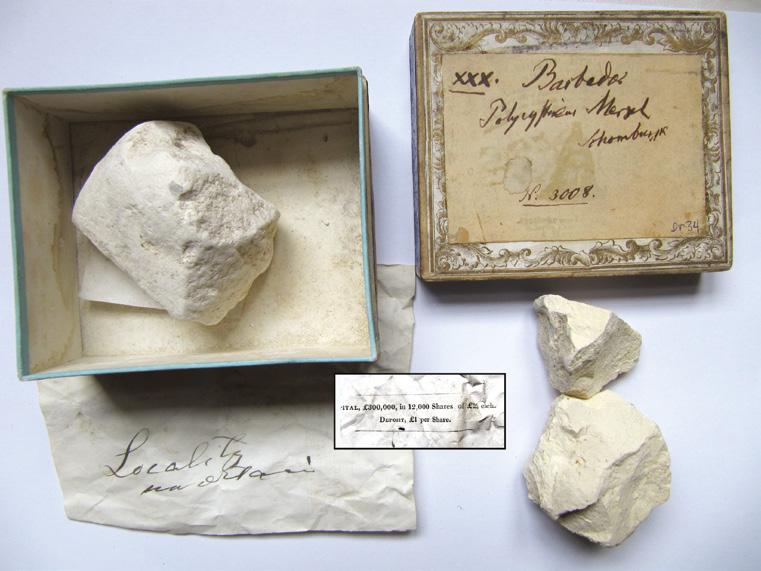
Figure 1.6 Ehrenberg Collection sample of Eocene radiolarian chalk, Barbados. One of several samples from Barbados in the Ehrenberg Collection. Determining the geologic context of historical material is challenging and requires historical research, as this sample illustrates. The material was given to Ehrenberg by Sir Robert Schomburgk (Ehrenberg, 1846, 1847), who like many naturalists explored the Americas in the early 1800s. Although Schomburgk was originally German he spent most of his career in English-speaking countries and he may well have personally collected the material even though the label in the box: “Locality uncertain” is in English, as is the scrap of paper it was written on (the back, shown in the inset, apparently refers to a stock offering in English Pounds). Schomburgk was at the time stationed on British government business in Barbados (Robert Hermann Schomburgk, Wikipedia, accessed 17.8.19) and may simply have failed to note precisely where the material was collected. No details are given in the Ehrenberg publications as to the extent of the material, other than stating that “several fist-sized” pieces were included. The presence of multiple individual geologic objects, sometimes with clearly different geologic characteristics in a single “sample,” is common in such historic collections. Anna Jobst, the archivist who databased the collection, by matching different published sources and collection records suggested that the sample(s) can be assigned to the peak of Mount Hillaby (Ehrenberg Collection database, accessed 17.8.19). This would place them several km away from the better known material from modern studies of Barbados microfossils of the Bath Cliffs (Saunders et al., 1985), though still part of the Eocene nappes of pelagic sediments that are present in the island’s geology (Donovan, 2005).
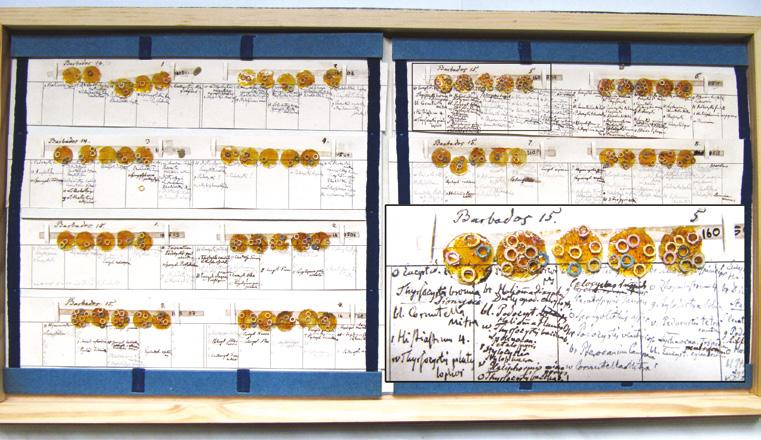
Figure 1.7 Ehrenberg mica microscopic preparations (here cabinet 15, tray 5). Ehrenberg made his preparations on small round discs of mica, on which he melted a thin layer of Canada Balsam then sprinkled the source material over. He generally made at least 5, and often more than 30 such discs from a single sample (though note that “sample” is somewhat ambiguous – see caption to Figure 1.6). For storage, groups of 5 discs were glued, using more balsam, onto a thin mica strip and inserted into slots cut into a broad paper mounting strip. Specimens of interest were marked by small colored paper rings on the micas and the taxonomic name noted with an abbreviation to the ring color on the strip of paper underneath, with blocked areas corresponding to the sequence of micas. Strips were bundled into cardboard folders, and in turn held in larger cardboard boxes resembling books. With the passing of years, the micas began to loosen from the mica strips, and break during opening or closing the folders. They were thus transferred to the tray system used today. Given the very limited space Ehrenberg’s taxonomic names were often abbreviated and are frequently hard to read, even in close-up (see inset). As Ehrenberg worked prior to the development of the concept of type specimens, there is no indication in the collection which mica or ring holds the specimens used in his original species description publications. This makes finding the ca. 2,000 type specimens for his published species (all taxonomic groups included) challenging, as there are ca. 40,000 micas in the collection. Given the rough surface of the micas and the optical flaws of the mica backing, imaging the specimens once found is also sometimes difficult. After Lazarus (1998) and Lazarus and Jahn (1998).
described over 500 radiolarian species and more than 70 genera (Suzuki, 2009), and of these at least 159 species and most of his genera are known to be accepted and in current use (Lazarus et al., 2015). The taxonomic status of many more of his species are under revision, based on a foundational
re-examination of Ehrenberg’s original collections (individual chapters in Tanimura and Aita, 2009; see also Chapter 5: Taxonomy and Fossil Record).
Johannes Müller (1801–1858, Figure 1.8) was a very influential biologist (see, e.g. Otis, 2007) who carried out the first extensive
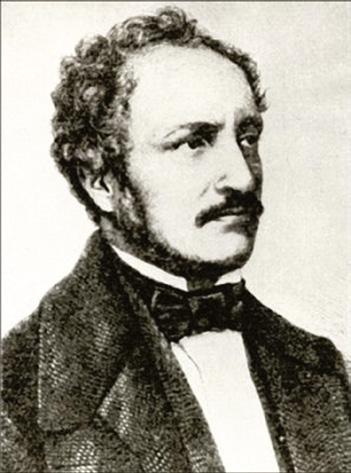
studies of living radiolarians, though the very first usable description is that of Huxley (1851), who briefly described (three text pages and a plate) collosphaerid colonies and the large solitary species Thalassicolla nucleata Huxley. Although Müller’s interest in the diversity of nature was lifelong, for much of his early career he concentrated on medicine, where he substantially advanced the field of physiology (summarized in his multivolume Handbuch der Physiologie des Menschen, published between 1833–1840). Beginning in the 1840s and until his premature death in 1858, he studied many groups of invertebrates, ending with five published studies of living radiolarians from coastal seas in the Mediterranean (1855–1858). The last of these in particular introduced the word “radiolaria” for the group and gave detailed descriptions and illustrations of numerous living species (with dozens of new species
and genera) of acantharians, spumellarians, nassellarians, and collodarians. His text discussed details of both cytoplasm and skeleton, and together with his illustrations provided a starting point for future biologic studies, particularly those of his student Ernst Haeckel.
Second Half of the Nineteenth Century to ca. 1920
E. Haeckel and his disciples Ernst Haeckel (1834–1919, Figure 1.9) was without question the single most important individual ever to study radiolarians: measured both by his radiolarian studies, and by his general importance to human
Figure 1.8 Johannes Müller. Source: Image archives of the Humboldt University, Berlin.
Figure 1.9 Ernst Haeckel, ca. 1860. Source: Wikimedia Commons.
history, as Haeckel was also very active in other areas of biology, science popularization, and in politics (Gasman, 2004; Richards, 2008). Building on the foundations of shell morphologic descriptions by Ehrenberg and cell biology by his doctoral advisor J. Müller, Haeckel named (although often failed to adequately describe) literally thousands of radiolarian species, both fossil and living. He also popularized radiolarians (and other groups of organisms), and explicitly linked radiolarian taxonomy to Darwinian evolutionary theory. The only areas of radiolarian research he did not profoundly influence were the study of pre-Cenozoic forms, or the use of radiolarians in geologic research, e.g. for biostratigraphy.
Haeckel came from an upper middleclass family and initially studied medicine. He soon shifted to studying zoology under, among others, Karl Gegenbauer and J. Müller. During an extended trip to Italy, Haeckel began in 1859 to study radiolarians from the coastal waters off Messina, as Müller had done earlier. These studies were extended into his Habilitation work (formal qualification for a professorship in classical European academic systems), which was published (Haeckel, 1862) as his first major work on radiolarians. He was appointed to the first professorship in Germany dedicated to the new discipline of zoology in 1865 (Entzeroth and Hausmann, 1993). Haeckel carried out extensive studies of many types of organisms including vertebrates, sponges, and coelenterates over the next two decades and became very active in promoting, via talks and publications, Darwin’s evolutionary theory. Based on his 1862 publication he was given the radiolarians from the recent Challenger Expedition to analyze. His report, published in 1887, was one of the largest published in the Challenger series, and remains to this day the most extensive single work ever published on radiolarians, with 2,750 pages and 140
plates in 3 large volumes. Haeckel concentrated more and more on political and popular science activities from around 1900 until his death in 1919.
Haeckel is primarily known both to scientists and to historians not for his radiolarian studies, massive though they were, but for his other scientific work, his popularization of biology including biodiversity and evolution, and his promotion of a political version of evolution. Haeckel was an important figure in biology in the second half of the nineteenth century, producing major syntheses of general metazoan morphology, developmental biology, and evolution, e.g. his Generelle Morphologie (Haeckel, 1866). He is famous in biology for, among other ideas, his theory that “ontogeny recapitulates phylogeny,” as well as for coining many biologic terms, such as “ecology.” Haeckel attempted to insert evolutionary biology into politics and sociology, promoting racial theories and eugenics. Haeckel also founded a new school of philosophy – Monism – many members of which also promoted his political views, and not a few became active members of the Nazi Party. Haeckel was however also cited by communist activists. Because of his major role not only in nineteenth-century biology but his complex, problematic contribution to political ideas in Germany, he is a controversial figure and a regular subject for historical study. See, for example, Gasman (2004) and Richards (2008) for decidedly different interpretations of his person and historical role. Haeckel’s popular works e.g. Kunstformen der Natur (Haeckel, 1904) introduced radiolarians to the general public, played a role in linking the biology of form to the then-current Art Deco movement (Kockerbeck, 1986), and to this day remain popular and continue to inspire artists and students of biologic form.
Haeckel provided the first comprehensive description of all aspects of radiolarian
diversity – species descriptions, higher level taxonomic concepts, morphologic characteristics. His studies of living radiolarians were devoted approximately equally to all major groups of marine rhizarians, all of which at that time were called “radiolaria”: Spumellaria and Nassellaria (Polycystina), Acantharia and Phaeodaria; the latter two groups today are no longer considered radiolarians in the modern sense of the word. Haeckel described in all over 3,000 new species, several hundred genera (counting subgenera, over 1,000), and dozens of families alone for the Polycystina (precise numbers are not available as current databases partially still mix information on Polycystina, Acantharia, and Phaeodaria together. See also Chapter 5: Taxonomy and Fossil Record). Haeckel’s first major work on radiolarians in 1862 covered, in great detail, every aspect of radiolarian biology in over 200 text pages and 38 plates, including cellular morphology, behavior, biogeography, reproduction, and taxonomy – a quantum leap in our understanding of the group. One reason for this is that Haeckel, unlike Ehrenberg, who used the same early nineteenth-century model throughout his life, used then stateof-the-art microscopes (his first, custommade for him in 1853 from the Berlin manufacturer Schieck; Otis, 2007) which allowed him to see much more cellular detail than earlier workers. After becoming professor, Haeckel could amplify his interest in radiolarians through his students and followers – notably Hertwig (1876, 1879); Bütschlii (1882); Dreyer (1889); Jorgensen (1905); Popofsky (1908); and Mast (1910) – protozoologists who continued his biologically oriented examination of the group. Many of these studies were, similar to Haeckel’s (1887) work, connected to the exploratory marine research expeditions which characterized the latter nineteenth and early twentieth centuries. Haeckel’s (1887) monograph however remains unique in the scope and detail of
its results, although many of his described taxa are problematic, as discussed in Chapter 5 (Taxonomy and Fossil Record).
Roughly in parallel to the growth of these early biologic studies, other studies describing only fossil forms continued to be produced in Europe, often more similar in style to Ehrenberg than Haeckel, e.g. Stöhr (1880), Bütschli (1882), Dreyer (1889), and Tan (1927) on Cenozoic materials. An important extension to study of pre-Cenozoic materials also occurred, e.g. Pantanelli (1880), Hinde (1890; Fig. 1.10), Rüst (1892), and Squinabol (1904) on Mesozoic and Paleozoic materials. These latter studies,
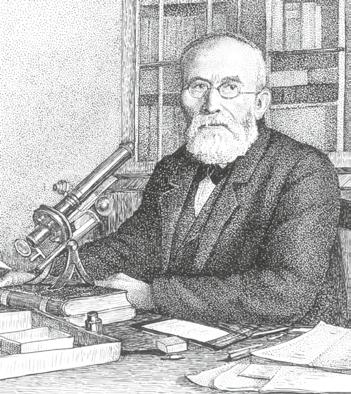
Figure 1.10 George J. Hinde (1839–1918). Son of a factory owner in England, Hinde began his career as a farmer in England, then worked for several years as a sheep rancher in Argentina. After further years of wandering and doing geologic research in North America, Hinde returned to England in 1874 and was elected a Fellow of the Geological Society of London. From then on, he concentrated on studies of various invertebrate, mostly Paleozoic microfossil groups, including sponges, conodonts, and radiolaria (Woodward, 1918). He described in all 231 new radiolarian species (Suzuki Paleotax database) Source: illustration provided by M. Afanasieva.
